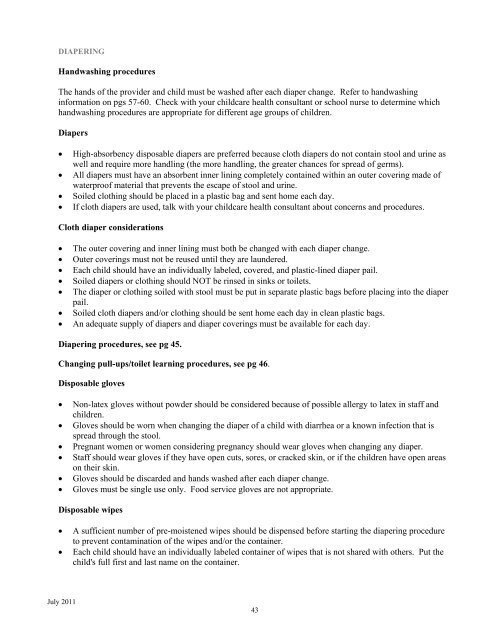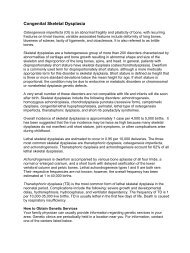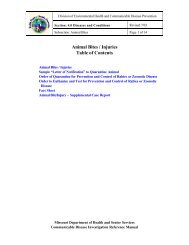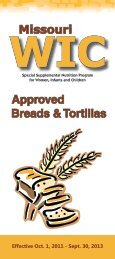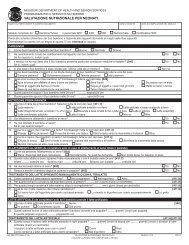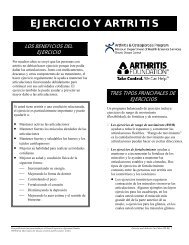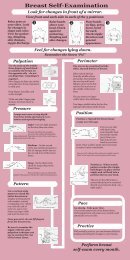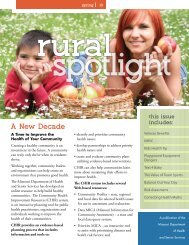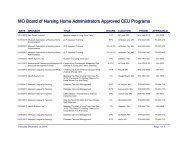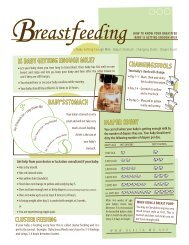Prevention and Control of Communicable Diseases - Missouri ...
Prevention and Control of Communicable Diseases - Missouri ...
Prevention and Control of Communicable Diseases - Missouri ...
You also want an ePaper? Increase the reach of your titles
YUMPU automatically turns print PDFs into web optimized ePapers that Google loves.
DIAPERING<br />
H<strong>and</strong>washing procedures<br />
The h<strong>and</strong>s <strong>of</strong> the provider <strong>and</strong> child must be washed after each diaper change. Refer to h<strong>and</strong>washing<br />
information on pgs 57-60. Check with your childcare health consultant or school nurse to determine which<br />
h<strong>and</strong>washing procedures are appropriate for different age groups <strong>of</strong> children.<br />
Diapers<br />
� High-absorbency disposable diapers are preferred because cloth diapers do not contain stool <strong>and</strong> urine as<br />
well <strong>and</strong> require more h<strong>and</strong>ling (the more h<strong>and</strong>ling, the greater chances for spread <strong>of</strong> germs).<br />
� All diapers must have an absorbent inner lining completely contained within an outer covering made <strong>of</strong><br />
waterpro<strong>of</strong> material that prevents the escape <strong>of</strong> stool <strong>and</strong> urine.<br />
� Soiled clothing should be placed in a plastic bag <strong>and</strong> sent home each day.<br />
� If cloth diapers are used, talk with your childcare health consultant about concerns <strong>and</strong> procedures.<br />
Cloth diaper considerations<br />
� The outer covering <strong>and</strong> inner lining must both be changed with each diaper change.<br />
� Outer coverings must not be reused until they are laundered.<br />
� Each child should have an individually labeled, covered, <strong>and</strong> plastic-lined diaper pail.<br />
� Soiled diapers or clothing should NOT be rinsed in sinks or toilets.<br />
� The diaper or clothing soiled with stool must be put in separate plastic bags before placing into the diaper<br />
pail.<br />
� Soiled cloth diapers <strong>and</strong>/or clothing should be sent home each day in clean plastic bags.<br />
� An adequate supply <strong>of</strong> diapers <strong>and</strong> diaper coverings must be available for each day.<br />
Diapering procedures, see pg 45.<br />
Changing pull-ups/toilet learning procedures, see pg 46.<br />
Disposable gloves<br />
� Non-latex gloves without powder should be considered because <strong>of</strong> possible allergy to latex in staff <strong>and</strong><br />
children.<br />
� Gloves should be worn when changing the diaper <strong>of</strong> a child with diarrhea or a known infection that is<br />
spread through the stool.<br />
� Pregnant women or women considering pregnancy should wear gloves when changing any diaper.<br />
� Staff should wear gloves if they have open cuts, sores, or cracked skin, or if the children have open areas<br />
on their skin.<br />
� Gloves should be discarded <strong>and</strong> h<strong>and</strong>s washed after each diaper change.<br />
� Gloves must be single use only. Food service gloves are not appropriate.<br />
Disposable wipes<br />
� A sufficient number <strong>of</strong> pre-moistened wipes should be dispensed before starting the diapering procedure<br />
to prevent contamination <strong>of</strong> the wipes <strong>and</strong>/or the container.<br />
� Each child should have an individually labeled container <strong>of</strong> wipes that is not shared with others. Put the<br />
child's full first <strong>and</strong> last name on the container.<br />
July 2011<br />
43


